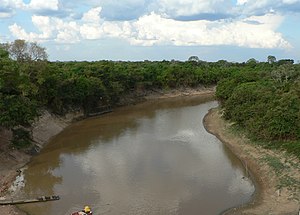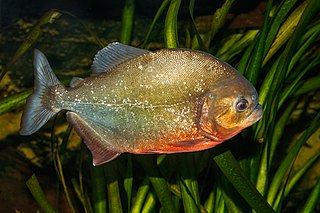
A piranha or piraña, a member of family Serrasalmidae, or a member of the subfamily Serrasalminae within the tetra family, Characidae in order Characiformes, is a freshwater fish that inhabits South American rivers, floodplains, lakes and reservoirs. Although often described as extremely predatory and mainly feeding on fish, their dietary habits vary extensively, and they will also take plant material, leading to their classification as omnivorous.
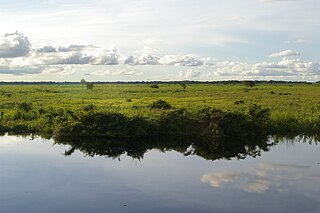
Beni, sometimes El Beni, is a northeastern department of Bolivia, in the lowlands region of the country. It is the second-largest department in the country, covering 213,564 square kilometers, and it was created by supreme decree on November 18, 1842 during the administration of General José Ballivián. Its capital is Trinidad.

The yacare caiman, also known commonly as the jacare caiman, Spanish yacaré, Paraguayan caiman, piranha caiman, red caiman, southern spectacled caiman, jacaré in Portuguese, and îakaré in Old Tupi, is a species of caiman, a crocodilian in the family Alligatoridae. The species is endemic to Argentina, Bolivia, Brazil, and Paraguay. Brown in color and covered with dark blotches, males grow to a total length of 2–3 m (6.6–9.8 ft) and females to 1.4 m (4.6 ft). Typical habitats of this caiman include lakes, rivers, and wetlands. Its diet primarily consists of aquatic animals, such as snails, and occasionally land vertebrates. Mating occurs in the rainy season and eggs hatch in March, with young fending for themselves as soon as they hatch. The yacare caiman was hunted heavily for its skin to use for leather in the 1980s, which caused its population to decrease significantly. However, trading restrictions placed since have caused its population to increase. Its population in the Pantanal is about 10 million, and it is listed as least concern on the IUCN Red List.

Arapaima gigas, also known as pirarucu, is a species of arapaima native to the basin of the Amazon River. Once believed to be the sole species in the genus, it is among the largest freshwater fish. The species is an obligate air-breather and needs to come to the surface regularly to gulp air.
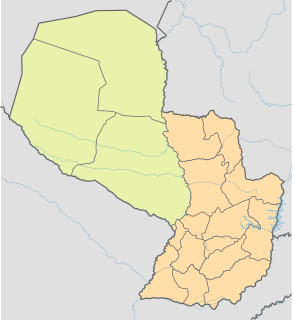
The Paraguayan Chaco or Región Occidental is a semi-arid region in Paraguay, with a very low population density. The area is being rapidly deforested. Consisting of more than 60% of Paraguay's land area, but with less than 10% of the population, the Chaco is one of the most sparsely inhabited areas in South America.

Trinidad, Kimsantin officially La Santísima Trinidad, is a city in Bolivia, capital of the department of Beni. The population is 130,000. While historically a peripheral city in Bolivia, Trinidad is today an important center for the Bolivian Bovine industry and has enjoyed a modest economic boom in recent years and enjoys an HDI index of above 0.700.

Carrasco is a province in the Cochabamba Department in central Bolivia. Its capital is Totora.

Pygocentrus is a genus of the piranha family Serrasalmidae. All species are native to tropical and subtropical South America. All the species are predatory, scavengers and may form large schools. The famous red-bellied piranha, Pygocentrus nattereri, is one of four species in the genus.

St Harmon is a village in Radnorshire, Powys, Wales. The population of the Community at the 2011 census was 593. It is located on the Afon Marteg on the B4518 road running between Llanidloes and Rhayader. The parish church is called Saint Garmon, with many people assuming it has been spelt incorrectly. In fact, the village name of St Harmon is a further Anglicisation of the name St Garmon. St Garmon's Church is known for having the diarist the Reverend Francis Kilvert serve as Vicar there between 1876-1877. It did have its own railway station- St Harmons railway station.
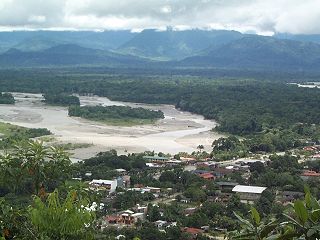
Villa Tunari or Tunari is a location in the department of Cochabamba, Bolivia. It is the seat of the Villa Tunari Municipality, the third municipal section of the Chapare Province. According to the census 2012 the population was 3,213 in the town which is an increment from 2,510 registered during the 2001 census.

The red-bellied piranha, also known as the red piranha, is a species of piranha native to South America, found in the Amazon, Paraguay, Paraná and Essequibo basins, as well as coastal rivers of northeastern Brazil. This fish is locally abundant in its freshwater habitat. They are omnivorous foragers and feed on insects, worms, crustaceans and fish. They are not a migratory species, but do travel to seek out conditions conducive to breeding and spawning during periods of increased rainfall. Red-bellied piranhas often travel in shoals as a predatory defense, but rarely exhibit group hunting behavior. Acoustic communication is common, and is sometimes exhibited along with aggressive behaviors. They are a popular aquarium fish.

Guayaramerín is a city within the Bolivian Beni Department. It is the capital of the Guayaramerín Municipality in the Vaca Díez Province. Guayaramerín is located on the west side of the Mamoré River, facing the Brazilian city of Guajará-Mirim. It is a port in which there is a permanent port of the Bolivian Navy. Guayaramerín Airport is south of the city, and is served by three local airlines: Ecojet, and Amaszonas.
Broad Run is a tributary stream of the Potomac River in Montgomery County, Maryland. The headwaters of the stream originate west of the town of Poolesville, and the creek flows southward for 8.9 miles (14.3 km) to the Potomac River. The Broad Run and its watershed are almost entirely within the Montgomery County Agricultural Reserve.

Puerto Teresa Río Yata is a newly built community located in the northeast region of the Beni Department on the Bolivian Pacific – Atlantic highway and at the Yata River, a tributary of the Beni River. It is part of the community of Santa Rosa de Yacuma in the José Ballivián Province of the Beni Department. It was founded on September 17, 1991.
Alalay Municipality is the third municipal section of the Mizque Province in the Cochabamba Department, Bolivia. Its seat is Alalay.
Jatun Mayu which downstream successively is named Challajtiri Mayu, Rosario, Agua Castilla, Jatun Mayu again and Qaysa is a Bolivian river in the provinces of Antonio Quijarro, José María Linares and Tomás Frías of the Potosí Department. It belongs to the Pillku Mayu river basin.
Inglaterra Airport is an airstrip in the lightly populated pampa of the Beni Department in Bolivia. It is 10 kilometres (6.2 mi) east of the village of Puerto Yata, and 74 kilometres (46 mi) northeast of Santa Rosa de Yacuma, the nearest town in the region. The runway is near a large meander of the Yata River.
La India Airport is an airstrip serving the Yata River village of La India in the Beni Department of Bolivia.

The Chácobo are an indigenous people of Bolivia who number 1,532 in 2012. They primarily live near the Ivon y Medio River and Benicito River in Beni of northeastern Bolivia. One band also lives near the Yata River.

NGC 4861, also known as Arp 266, is a galaxy in the constellation Canes Venatici. It was discovered by William Herschel on May 1, 1785.
